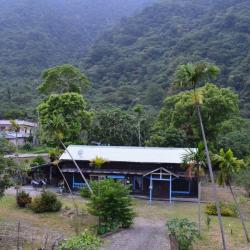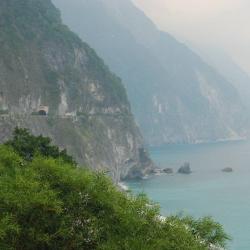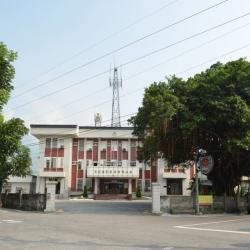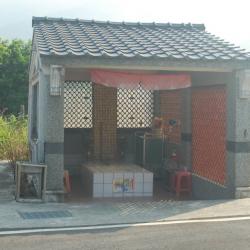The Luo Dachun Road Excavation Monument is located inside the pavilion next to Zhennan Temple on Chaoyang Road in Su’ao Township of Yilan County. It is respected by locals as Shipaizigong. Every year on July 29 of the lunar calendar many people come to pay respect here. In fact, the Luo Dachun Road Excavation Monument was originally set up on an historic trail about 300 meters southeast from the current site, facing Hualien. However, due to the excavation of Nan’ao area, the current Chaoyang Road has become an important passage to and from Nan’ao. Gradually, the historic trail got abandoned and got made into a water diversion channel. The remains of the barren tomb beside the historic trail were discovered during the reclamation, and the locals enshrine it with the excavation monument for people to remember.
Linhai Road

Located in Xiulin Township, Hualien County, the Gukut Police Post is located 300 meters south of the Hezhong Hamlet. It is now a residential house, but still retains a complete wooden structure from the Japanese occupation period. In the past, the Truku people expanded north and established hamlets on the hillside, with the Pacific Ocean in the east and the central mountain range in the west. As the terrain and space resemble a circular pan-bottom, the place was named Gukut, and was the earliest settlement of the Truku people. However, during the Japanese occupation, several hamlets were collectively moved to the present location, and continued with the name “Gukut”.
In the post-war period, Gukut Hamlet was renamed to Heping, and later called Hezhong because it was located in the middle of three communities of Heping Village.

The Qingshui Cliff in Xiulin Township, Hualien County is located on the way between Su’ao and Hualien Port. It was excavated by the Government-General in Taiwan during the Japanese occupation in 1916. Due to the needs of developing the eastern area and that the location was closest to the Governor Office, the 12-foot-wide historic walking trail was widened to make into roads for car traffic. The road passes through many indigenous villages and was named Linhai Historic Trail. Up until today, the Suhua Linhai Historic Trail has undergone many road-widening and adjustments, with old cliff roads replaced by tunnels to prevent danger caused by falling rocks.

The Suhua Historic Trail, which runs through Su’ao Township in Yilan County and Hualien City in Hualien County, was first excavated in 1874 (Qing period). The trail starts from Su’ao in the north and ends in Hualien Port in the south, with a total length of about 115 km. During the Japanese occupation in 1916, the Government-General in Taiwan began re-building the road between Su’ao and Hualien Port, which went all the way from Baimi Bridge in Su’ao to Zhuzi Bridge in Hualien Port Street. Later, the 12-foot-wide trail was converted into a road for car traffic that passes through many indigenous villages.
Today, the Yilan section of the Suhua Historic Trail that was excavated during the Qing Dynasty remained the same, while the Suhua Linhai Historic Trail along the coast that was built during the Japanese occupation has undergone many road-widening and adjustments. The old cliff road was even replaced with tunnels to prevent danger caused by falling rocks.

The police station in Xincheng Township, Hualien County was originally the Yanhai branch office that was established by the Government-General in Taiwan during the Japanese occupation. Today, the fence of the building still remains. After the Taroko War in 1914, Sakuma Samata, the Governor at that time, was deeply admired in Hualien. In commemoration of his achievements, the Government-General in Taiwan merged the Xincheng Branch and the Taroko Branch in 1920 and named it Yanhai after Sakuma.
Later in 1937, there was a restructure of the Hualien area; and the branch offices became counties, while districts were changed to townships. Since then, the Yanhai Branch in Hualien County governed the current Xincheng Township and Xiulin Township. After the war, the National Government restored Yanhai to its old name “Xincheng”.
